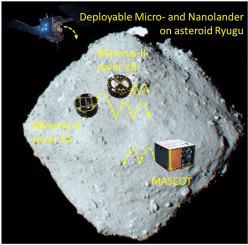当前位置:
X-MOL 学术
›
Planet. Space Sci.
›
论文详情
Our official English website, www.x-mol.net, welcomes your
feedback! (Note: you will need to create a separate account there.)
Micro- and nanolander on the surface of Ryugu – commonalities, differences and lessons learned for future microgravity exploration
Planetary and Space Science ( IF 1.8 ) Pub Date : 2020-12-01 , DOI: 10.1016/j.pss.2020.105094 Caroline Lange , Tetsuo Yoshimitsu , Stephan Ulamec , Catherin Düvel , Tra-Mi Ho
Planetary and Space Science ( IF 1.8 ) Pub Date : 2020-12-01 , DOI: 10.1016/j.pss.2020.105094 Caroline Lange , Tetsuo Yoshimitsu , Stephan Ulamec , Catherin Düvel , Tra-Mi Ho

|
Abstract Recent Space missions to the small bodies in our Solar System have shown an increasing importance of in-situ investigations. Philae, the comet lander of the ESA Rosetta mission performed the first landing on such a small body and its results clearly enhanced the overall scientific output of the Rosetta mission. While Philae was a rather heavy (~100 kg), very complex (and comparably expensive) lander, significant scientific results can be obtained also with much smaller devices. This has not least been demonstrated by the Hayabusa2 mission, delivering the MINERVA II and MASCOT landers to the surface of (162173)Ryugu. In this paper we will compare the benefits (and drawbacks) of surface packages in the 10 kg and 10 cubic decimeter class (MASCOT-Type) with the smaller (volume ~1 cubic decimeter and mass
中文翻译:

Ryugu 表面的微型和纳米着陆器——未来微重力探索的共性、差异和经验教训
摘要 最近对太阳系中小天体的太空任务表明,原位调查越来越重要。欧空局罗塞塔任务的彗星着陆器菲莱首次在如此小的天体上着陆,其结果明显增强了罗塞塔任务的整体科学产出。虽然菲莱是一个相当重(约 100 公斤)、非常复杂(且相对昂贵)的着陆器,但使用更小的设备也可以获得重要的科学成果。Hayabusa2 任务证明了这一点,将 MINERVA II 和 MASCOT 着陆器运送到 (162173) Ryugu 的表面。在本文中,我们将比较 10 kg 和 10 立方分米级(MASCOT-Type)表面包装与较小(体积 ~1 立方分米和质量)的表面包装的优点(和缺点)
更新日期:2020-12-01
中文翻译:

Ryugu 表面的微型和纳米着陆器——未来微重力探索的共性、差异和经验教训
摘要 最近对太阳系中小天体的太空任务表明,原位调查越来越重要。欧空局罗塞塔任务的彗星着陆器菲莱首次在如此小的天体上着陆,其结果明显增强了罗塞塔任务的整体科学产出。虽然菲莱是一个相当重(约 100 公斤)、非常复杂(且相对昂贵)的着陆器,但使用更小的设备也可以获得重要的科学成果。Hayabusa2 任务证明了这一点,将 MINERVA II 和 MASCOT 着陆器运送到 (162173) Ryugu 的表面。在本文中,我们将比较 10 kg 和 10 立方分米级(MASCOT-Type)表面包装与较小(体积 ~1 立方分米和质量)的表面包装的优点(和缺点)










































 京公网安备 11010802027423号
京公网安备 11010802027423号